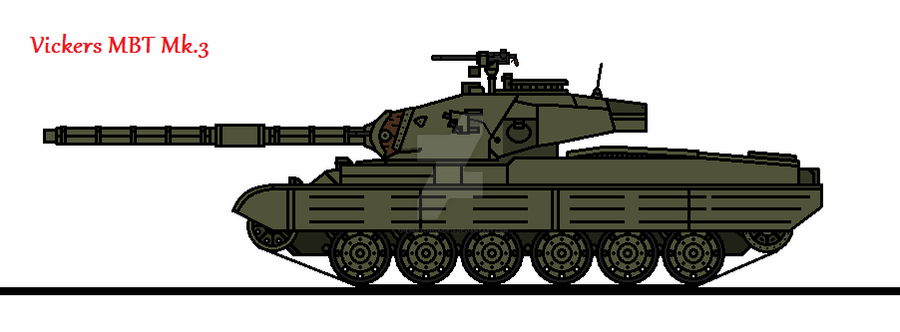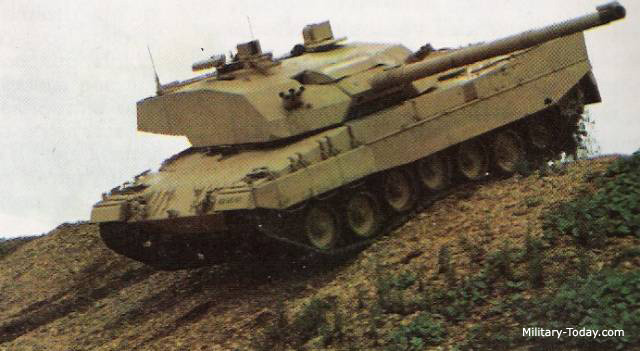Much like Tentative Fleet Plan below, the historical failure of Chieftain doesn't mean a Centurion evolution would have been a better alternative, especially considering that the British industrial/military/political flaws that plagued Chieftain would also have plagued (and did plague!) Centurion regardless. At least a clean sheet like Chieftain was a better base for a 60's British tank than Centurion, which had a less efficient shape, size and internal arrangement (smaller turret ring than postwar vehicles, large and heavy without actually using internal space correctly, less armor for the weight than even other Western competitors, bigger target).
Not sure why we're trying to fix something that isn't broken, other than the L60 engine of course.
Remember that the Israelis did not have to face the composite-armoured, 125mm smoothbore-armed T-64s and T-80s, which the 105mm would struggle with, and something which BAOR would undoubtedly face, given that they were situated on the North German Plain, where the Soviets planned to make their push to Antwerp, thus placed their best formations.
If we're going to fix the 120mm L11, it's only problem is that it isn't smoothbore and didn't fire APFSDS. The Soviet 100mm T-12 Smoothbore Anti-Tank gun enters service in 1961, the 115mm U5-TS Molot 115mm, and 115mm D68-T gun for the Object 432/T-64 sans-sufix in 1964. With these guns the Soviets were able to achieve similar performance with APFSDS with monobloc steel penetrators (and considerably superior performance with tungsten-carbide penetrators) to NATO guns firing APDS with tungsten penetrators.
Again the only problem with Chieftain's protection is the fact that it is using monolithic cast and welded rolled steel, when the Soviets are beginning to use composite armour with fibreglass for the glacis and ceramic balls and aluminium matrix for the turret for Object 432/T-64 sans-sufix in 1964.
It should be pointed out that the Soviets achieved this all on 35 tons whereas Chieftain was 55 tons (comparable with the design weight of the last generation of Soviet Heavy tanks like Object 279 and 770).
What could NATO have achieved with advances like smoothbore guns and composite armour freed from the Soviet's constraint of 35 tons, taking advantage of a 55-ton design weight and married to already-existing NATO advantages like superior ergonomics, fire control and training?
Remember we're talking about 50's Britain, a country that sure invested a lot in the military at the time but with an inept procurement system, a weakening industry and limited financial ressources. None of those factors really encourage pushing the enveloppe like the US did. L11 seems like a British compromise in that regard, with tungsten alloy APDS and bagged charges being better than what preceded them and mature, but worse than the less mature APFSDS and semi-combustible cartridges developped by the US which became viable in the 70's (though the Soviets achieved both in the late 50's, showing the West could have come up with successful designs this early).
But yes, if the West managed to achieve Soviet successes while keeping their respective advantages, they would have been able to do much more than the Soviets that were overly constrained by some technical hurdles and excessive weight and size requirements.
In any case, fixing Chieftain itself with British ressources would have required:
- Vickers' torsion bar design in use on all British AFVs bar tanks since the FV300 program, to reduce the weight and improve the performance of the suspension
- higher reliability/quality control standards. Chieftain DIDN'T HAVE to be unreliable even with its weight
- better management to enter service in time around 1962-63 with a mature engine. What makes Chieftain look dated is the fact it was not fully mature until the early 70s while its competitors were usually finished by the first half of the 60s.
- less schizophrenic powertrain design: you can't make a 50+ ton monster and only request the same engine power as Western tanks over 10 tonnes lighter, nor can you ask for a compact engine and then ruin the entire design by making it straight (ultra tall) with an arrangement that still makes the engine bay as large as those for supposedly bigger and more powerful engines AND not emphasize light weight and small size in the rest of the entire tank.
The British may prioritize protection over mobility unlike the rest of NATO, but that doesn't excuse such an absolutely retarded powertrain design that it's not even a tradeoff anymore!


